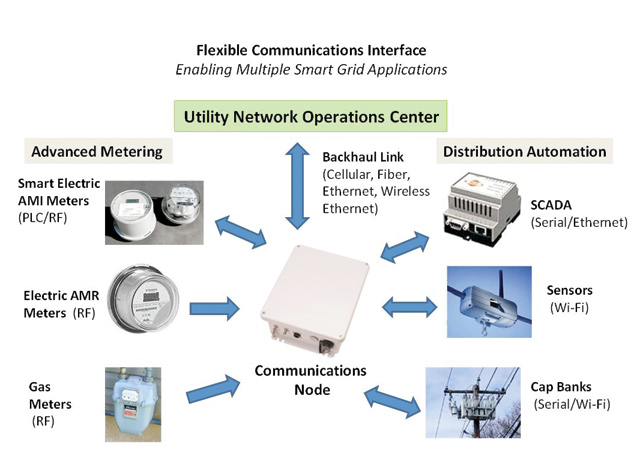Taking a look at the federal grants and stimulus packages, one would be led to believe that "smart grid" equals "smart meter". If only it were that simple. Some utilities are furiously charging forward, installing smart meters and slapping communications devices on poles and transformers of the distribution grid. But after this is done, more questions may come to mind only too late. What do you mean we can't deploy a different brand of meters? Why doesn't the communications node support various meter types or meter models? And why do we have to buy separate communications devices to support sensing for voltage and current reads? The answers can get pretty ugly. So let's face it, a little planning up front can go a long way to cost savings, facilitating future deployments, and getting the most out of the smart grid. Don't be a "one-hit AMI wonder" when you can make several smart grid hits on your communications strategy album. Here's how...

Lisa Ludwig, Vice President
Smart Grid Markets
& Applications
Ambient Corporation
Composing the Best Communications Solution
There are two key areas of consideration for your communications strategy: 1) smart grid applications desired beyond Advanced Metering Infrastructure (AMI) and 2) understanding the communications technology options that best suit the applications. Let’s examine this duet in further detail.
Applications: The Tracks for Your Smart Grid Album
Smart Grid Application Songs. So why do you need to think about smart grid applications beyond AMI now? What’s the big deal? Let’s start with an example. Many vendors offer an “AMI solution” that includes both the meters and communications device that delivers the meter reads to the utility. In this scenario, most have engineered the communications device with a proprietary interface to work only with a single meter brand. This is perhaps the most direct path to finding yourself locked in to a single meter supplier. It can be a baffling experience when you learn later that you can’t add additional meters from the same vendor that are different model numbers from the original deployment! Furthermore, it can also be frustrating to find the communications devices used in the original deployment are not interoperable with other brands of electric meters or other types of utility meters for water and gas.
Now let’s go beyond meters; do you want to entertain the opportunity to do monitoring and sensing? Measuring voltage, current, or something else? Do you want to be able to do partial discharge monitoring? Or do you want to focus on demand response applications such as peak load management or distributed generation? Obviously, it’s hard to know what you’ll need in ten years. But smart grid is a long-term investment so you’ll want your songs to continue to be hits for years to come.
Data Volumes and Tempo. Once you’ve figured out which applications will be most beneficial to your utility operations, you’ll need to size the data that these applications generate and scale your songs appropriately. Obviously, a little tap dancing will be required to come up with the numbers, but a calculator in hand and some assumptions will help.
For example, consider the amount of data and how often the data must be transmitted to the utility’s operations center. New electric meters can be configured to deliver once-amonth meter reads, hourly reads, or a fast tempo with reads at 15- minute intervals. Even if the same meter is used for each of the scenarios, the first scenario requires 12 messages a year, whereas the last scenario requires 35,040. Extrapolate this data increase across hundreds of thousands – ultimately millions – of meters, and the enabling communications requirements look very different. The nature of the data volume and tempo will dictate what network protocol options for are best suited for your applications.

Selecting Communications in Rhythm with Your Smart Grid Applications
Now that you’ve done your homework, having come up with the requirements or at least a wish list for smart grid applications, where do you start your quest for the ideal communications solution? What should you be looking for when evaluating communications nodes? Unless you want the one-hit AMI wonder, you can’t go wrong with the following chromatics to compose a harmonious communications solution.
Hitting All the Notes on the Technology Scale
- Flexible Interface. A flexible interface that can communicate with any IP-based device such as electric meters, gas meters, and distribution line sensors is key to leveraging current and future applications for the smart grid. Examples of applications derived from a flexible interface could include energy sensing for current and voltage levels or a partial discharge monitor that detects deterioration in power cables before they fail.
- Support for Multiple Network Protocols. Also key to enabling smart grid applications is a solution that supports multiple network protocols. The communications node should be configurable to the protocols required in various scenarios. Examples include Ethernet and serial ports, cellular, IEEE 802.11 (a/b/g) Wi-Fi, and Powerline Communications (PLC), and RF. The applications and environment will dictate which protocols are best suited for the smart grid communications solution.
- Layered Security. The communications nodes should be protected both at the physical and logical levels. The physical device should be encased in such a way that it cannot be opened by anyone who is not authorized (for example, a padlock). The logical level includes network and system access. SSH encrypted login should be available for network access. While system access should also support password encryption. Further, there should be varying levels of system access for users (i.e., normal vs. root).
- Mounting Options. Depending on the application and entry points on the grid, various mounting options should be available with the communications device selected. (Also, keep in mind that the optimal mounting scenario includes a single communications device with a small form factor.) The first and most obvious mounting option should include brackets for attaching the communications node to the utility pole or wall. Additionally, a kit that allows the node to be securely fixed to a transformer pad without having to modify the transformer cabinet should be available as an option.
- Weather Proof. The communications unit should be able to handle a range of weather conditions, from severe heat to extreme cold, rain, snow, and whistling winds to name a few.
- Automated Configuration. Deployment time is an underestimated expense. Shortening deployment can enable a faster ROI. Look for a system that automatically activates and registers itself upon installation. No need for a long configuration prelude if you find the right vendor.
- Backup Power Options. Look for solutions that offer both extended backup power and short-term backup power. Extended backup power should allow a node to continue running for a minimum of 15 minutes when AC power is lost, enabling utilities to continue monitoring the distribution system during an outage. Short-term backup power typically maintains the nodes connectivity for a minimum of 2 minutes, allowing it enough time to send an alarm that an outage has occurred.
- Remote Upgrades. Remote upgrades save truck rolls and resources in terms of time and money. A top-notch remote upgrade system will upgrade any firmware or software on the communications node – including the node operating system, component firmware, and module applications.
- Management and Reporting. Software designed to manage communications nodes in the smart grid network should be available to utilities as part of the communications solution. Look for a vendor that has a Web-based solution. This will facilitate management of the network by enabling utility operations personnel access to the network status any time, from anywhere. In addition to the network management capabilities, the system should be designed to collect information from the nodes at various intervals and generate reports.
Cost Considerations
Assuming your evaluation encompasses the elements mentioned above, chances are you will indeed find a more cost-effective solution than taking the “one-hit wonder” approach. At this point vendors will be narrowed down and you will hone in on the features vs. cost chorus.
A Final (Power) Chord
The smart grid hype can make us all want to be AMI rock stars and overnight sensations. But it’s important to remember that smart grid is a new and evolving style, and communications deployment mistakes now will make your album short-lived. Take the time to make sure your smart grid communications strategy will “rock on” for years to come.
About the Author
Lisa Ludwig is Vice President, Smart Grid Markets and Applications for Ambient Corporation. With over twenty years of high-tech experience, Lisa previously held executive roles in telecommunications, smart grid, security, and storage technology market segments. Prior to joining Ambient, Lisa was Senior Director at SEPATON, Inc., a virtual storage technology company focused on utilities, telecom and financial markets. Most notably, she was head of Ericsson’s worldwide Network Management Business Unit. Lisa has authored many articles and papers for industry trade magazines and IEEE publications and holds a B.S. in Computer Science from Merrimack College in North Andover, Massachusetts.







